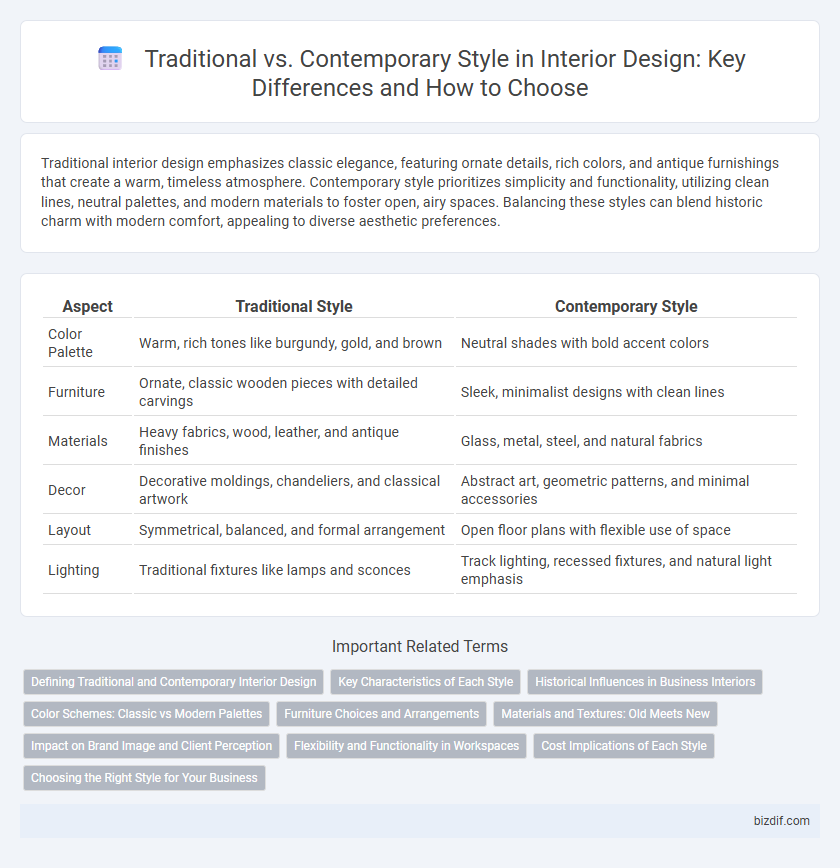Traditional interior design emphasizes classic elegance, featuring ornate details, rich colors, and antique furnishings that create a warm, timeless atmosphere. Contemporary style prioritizes simplicity and functionality, utilizing clean lines, neutral palettes, and modern materials to foster open, airy spaces. Balancing these styles can blend historic charm with modern comfort, appealing to diverse aesthetic preferences.
Table of Comparison
| Aspect | Traditional Style | Contemporary Style |
|---|---|---|
| Color Palette | Warm, rich tones like burgundy, gold, and brown | Neutral shades with bold accent colors |
| Furniture | Ornate, classic wooden pieces with detailed carvings | Sleek, minimalist designs with clean lines |
| Materials | Heavy fabrics, wood, leather, and antique finishes | Glass, metal, steel, and natural fabrics |
| Decor | Decorative moldings, chandeliers, and classical artwork | Abstract art, geometric patterns, and minimal accessories |
| Layout | Symmetrical, balanced, and formal arrangement | Open floor plans with flexible use of space |
| Lighting | Traditional fixtures like lamps and sconces | Track lighting, recessed fixtures, and natural light emphasis |
Defining Traditional and Contemporary Interior Design
Traditional interior design emphasizes rich colors, ornate details, and classic furnishings inspired by 18th and 19th-century European decor, creating a warm and timeless atmosphere. Contemporary interior design features clean lines, open spaces, and a neutral color palette with bold accents, reflecting current trends and minimalist influences. Defining both styles involves understanding traditional design's focus on symmetry and elegance versus contemporary's emphasis on simplicity and functionality.
Key Characteristics of Each Style
Traditional interior design features classic furniture, rich wood tones, and ornate detailing that evoke a timeless elegance, characterized by symmetry and warm, muted color palettes. Contemporary style emphasizes clean lines, minimalistic furniture, and neutral colors with bold accent pieces, focusing on open spaces and natural light to create a fresh, airy atmosphere. Key characteristics of traditional design include intricate patterns and textured fabrics, while contemporary interiors prioritize simplicity and functionality with smooth surfaces and innovative materials.
Historical Influences in Business Interiors
Traditional interior design in business spaces draws heavily on historical influences from the 18th and 19th centuries, incorporating ornate woodwork, classical motifs, and rich, warm color palettes that evoke a sense of heritage and stability. Contemporary business interiors, by contrast, are shaped by mid-20th-century modernism, emphasizing clean lines, minimalism, and functional materials such as steel and glass to create an open, airy environment. Understanding these historical roots enables businesses to align their interior design choices with their brand identity, whether aiming for timeless elegance or progressive innovation.
Color Schemes: Classic vs Modern Palettes
Traditional interior design embraces rich, warm color schemes such as deep reds, golds, and earthy browns, creating an inviting and timeless ambiance. Contemporary style favors neutral tones like grays, whites, and blacks, accented with bold pops of color such as teal, mustard, or coral for a clean, fresh look. The classic palettes emphasize comfort and heritage, while modern palettes highlight simplicity and vibrancy.
Furniture Choices and Arrangements
Traditional interior design features classic furniture with ornate details, rich wood finishes, and symmetrical arrangements that emphasize balance and formality. Contemporary style favors minimalistic, sleek furniture with clean lines, often using metal, glass, or engineered wood, arranged to create open, functional spaces. Furniture placement in traditional interiors tends to highlight conversation areas with evenly spaced seating, while contemporary layouts prioritize flow and multi-purpose use.
Materials and Textures: Old Meets New
Traditional interior design relies on rich, natural materials like hardwoods, marble, and silk, emphasizing ornate textures and intricate patterns that evoke a sense of history and craftsmanship. Contemporary style favors sleek, smooth surfaces such as glass, metal, and engineered wood, creating minimalist textures that highlight simplicity and innovation. Combining these materials and textures blends the warmth and depth of traditional elements with the clean, modern appeal of contemporary design, resulting in a balanced and dynamic interior.
Impact on Brand Image and Client Perception
Traditional interior design evokes a sense of heritage and reliability, reinforcing brand identity through classic aesthetics and timeless elements that appeal to clients seeking trust and stability. Contemporary design signals innovation and modernity, enhancing brand image by showcasing forward-thinking and adaptability, which attracts clients valuing cutting-edge trends and sleek functionality. Selecting between these styles directly influences client perception by aligning the physical environment with the desired brand message and market positioning.
Flexibility and Functionality in Workspaces
Traditional workspace design emphasizes fixed layouts with classic furnishings that prioritize aesthetic consistency but often limit adaptability. Contemporary style incorporates modular furniture and open layouts, enhancing flexibility and promoting multifunctional use of space. Emphasizing ergonomic solutions, contemporary workspaces support dynamic workflows and accommodate evolving technological needs.
Cost Implications of Each Style
Traditional interior design often involves higher costs due to the use of rich materials like hardwood, ornate furnishings, and detailed craftsmanship, which require skilled labor and time-intensive processes. Contemporary style tends to be more cost-effective given its emphasis on minimalism, functionality, and the use of modern, mass-produced materials such as metal, glass, and engineered wood. Budget planning should consider that while traditional designs incur higher upfront expenses, contemporary interiors may reduce long-term maintenance costs through simpler, durable elements.
Choosing the Right Style for Your Business
Selecting the appropriate interior design style for your business involves understanding the key distinctions between traditional and contemporary aesthetics. Traditional style emphasizes classic elements, rich textures, and ornate details, creating a warm, timeless atmosphere that appeals to clients seeking elegance and familiarity. In contrast, contemporary design focuses on clean lines, neutral color palettes, and functional minimalism, ideal for businesses aiming to project modernity and simplicity in their workspace.
Traditional vs Contemporary Style Infographic

 bizdif.com
bizdif.com